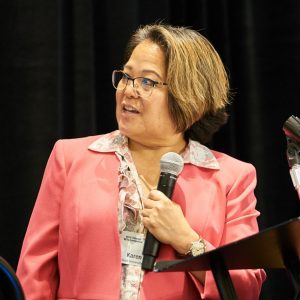Nuclear Medicine Treatments for Neuroendocrine Tumors
Home » For Patients old » NET Tests & Treatments » NET Treatments » Nuclear Medicine
Nuclear medicine as a treatment for neuroendocrine tumors has been used in Europe, Australia, and other countries for decades. It was FDA approved in the United States in 2018 after a multicenter clinical trial and expanded access protocol. This treatment delivers radiation directly to the tumor to kill cancer cells.
Peptide Receptor Radionuclide Therapy (PRRT)
Some NET cells, unlike healthy cells, have proteins on their cell surface called receptors, that can bind to hormones, such as somatostatin. PRRT with lutetium 177 dotatate (Lu-177) targets these receptors with radiopeptides.
- A peptide (a group of amino acids) is created that can bind to the receptors on a tumor cell’s surface.
- The peptide is then paired with a radionucleotide (a radioactive atom) using a chelator (bonding agent).
- The combination creates a radiopeptide.
- The radiopeptide is injected into a patient’s bloodstream.
- The radiopeptide finds and binds to the NET cancer cell’s somatostatin receptor.
- The radiopeptide emits radiation that kills the NET cancer cell.
Benefits of PRRT
Patients undergo multiple sessions of PRRT a few months apart. Studies have shown PRRT can:
- Increase progression-free survival and likely survival
- Improve the quality of life
- Relieve symptoms
- Decrease tumor size
Side effects of PRRT
PRRT is generally well tolerated. Common side-effects of radiopeptide therapy are:
- Nausea
- Vomiting
- Abdominal pain
- Fatigue
Other less common side-effects are bone, liver and kidney toxicity, and mild hair loss.

Blase Polite, MD, University of Chicago
How PRRT works and who benefits from it. Watch Video
Karen Ohara, Rush University Medical Center
What to expect during PRRT treatment. Watch Video
Chicago Panel
Physician panel discusses PRRT cases Watch Video
Wolfgang Weber, MD, Technical University of Munich
PRRT pioneer looks to future. Watch VideoJosie Rubio gained strength, hope, and inspiration on her path to PRRT.
Patient Story.

